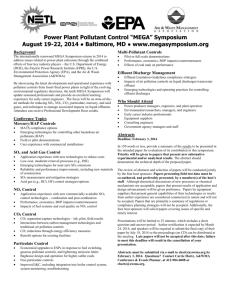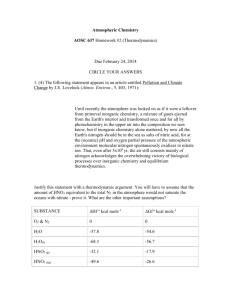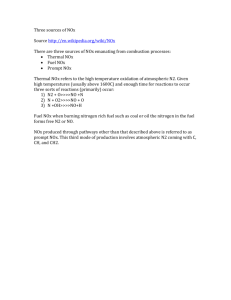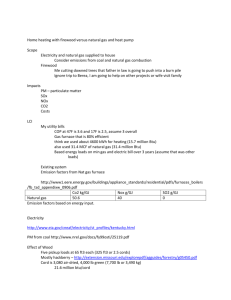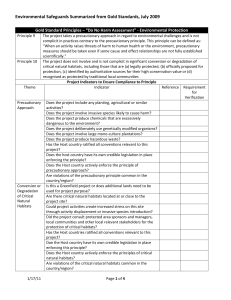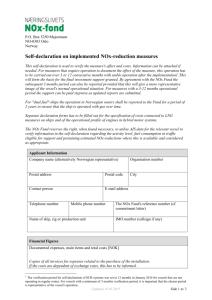balancing_environment_benefits_v2_20100505_4
advertisement
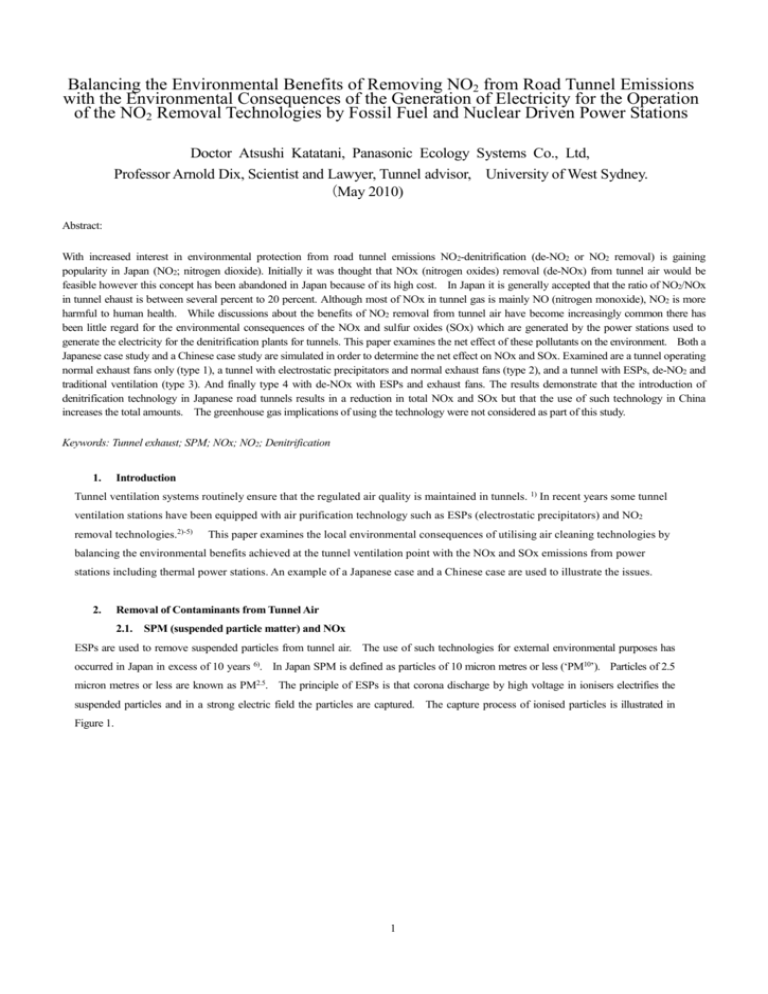
Balancing the Environmental Benefits of Removing NO2 from Road Tunnel Emissions with the Environmental Consequences of the Generation of Electricity for the Operation of the NO2 Removal Technologies by Fossil Fuel and Nuclear Driven Power Stations Doctor Atsushi Katatani, Panasonic Ecology Systems Co., Ltd, Professor Arnold Dix, Scientist and Lawyer, Tunnel advisor, University of West Sydney. (May 2010) Abstract: With increased interest in environmental protection from road tunnel emissions NO2-denitrification (de-NO2 or NO2 removal) is gaining popularity in Japan (NO2; nitrogen dioxide). Initially it was thought that NOx (nitrogen oxides) removal (de-NOx) from tunnel air would be feasible however this concept has been abandoned in Japan because of its high cost. In Japan it is generally accepted that the ratio of NO2/NOx in tunnel ehaust is between several percent to 20 percent. Although most of NOx in tunnel gas is mainly NO (nitrogen monoxide), NO2 is more harmful to human health. While discussions about the benefits of NO2 removal from tunnel air have become increasingly common there has been little regard for the environmental consequences of the NOx and sulfur oxides (SOx) which are generated by the power stations used to generate the electricity for the denitrification plants for tunnels. This paper examines the net effect of these pollutants on the environment. Both a Japanese case study and a Chinese case study are simulated in order to determine the net effect on NOx and SOx. Examined are a tunnel operating normal exhaust fans only (type 1), a tunnel with electrostatic precipitators and normal exhaust fans (type 2), and a tunnel with ESPs, de-NO2 and traditional ventilation (type 3). And finally type 4 with de-NOx with ESPs and exhaust fans. The results demonstrate that the introduction of denitrification technology in Japanese road tunnels results in a reduction in total NOx and SOx but that the use of such technology in China increases the total amounts. The greenhouse gas implications of using the technology were not considered as part of this study. Keywords: Tunnel exhaust; SPM; NOx; NO2; Denitrification 1. Introduction Tunnel ventilation systems routinely ensure that the regulated air quality is maintained in tunnels. 1) In recent years some tunnel ventilation stations have been equipped with air purification technology such as ESPs (electrostatic precipitators) and NO2 removal technologies.2)-5) This paper examines the local environmental consequences of utilising air cleaning technologies by balancing the environmental benefits achieved at the tunnel ventilation point with the NOx and SOx emissions from power stations including thermal power stations. An example of a Japanese case and a Chinese case are used to illustrate the issues. 2. Removal of Contaminants from Tunnel Air 2.1. SPM (suspended particle matter) and NOx ESPs are used to remove suspended particles from tunnel air. The use of such technologies for external environmental purposes has occurred in Japan in excess of 10 years 6). In Japan SPM is defined as particles of 10 micron metres or less (‘PM10’). Particles of 2.5 micron metres or less are known as PM2.5. The principle of ESPs is that corona discharge by high voltage in ionisers electrifies the suspended particles and in a strong electric field the particles are captured. The capture process of ionised particles is illustrated in Figure 1. 1 Fig.1 Typical structure of ESPs The ESP technology has been widely applied to purifying tunnel air 7) ,cleaning exhaust from thermal power plants8) and other processes in other industries. In recent years NO2 removal systems have enabled NO2 to be removed from tunnel exhaust air. These systems rely upon an efficient ESP to remove the particles prior to the NO2 removal. NO2 removal systems have been installed on the Shinjuku line tunnel in the Central Circular Route in Tokyo. 5) In Japan the principle of de-NO2 systems is that NO2 gas molecules in tunnel exhaust are adsorbed or absorbed as they pass through an adsorbent/absorbent material such as activated carbon. molecules 2) This process depends on the physical characteristics of adsorbing gas (refer to figure 2). The de-NO2 systems are less expensive, require less space and use significantly less power 3) than de-NOx systems. Fig.2 Theory of typical absorbent There is no regulation of NOx or NO concentration in Japan. However there are environmental regulations with respect to the concentration of NO2. In Japan NO2 concentration must not exceed a zone between 0.04 ppm and 0.06 ppm as shown in Table 1. Concentration of daily average SPM NO2 SO2 Not exceed 0.10 mg/m3 Within the zone from 0.04 ppm to 0.06 ppm ,or below that zone Not exceed 0.04 ppm - 2 - Table 1 Environmental Quality Standards of Japan In Japan it is considered that NO2 is more harmful to the human body than NO which ACGIH (American Conference of Government Industrial Hygienist) regulates as the value of 25ppm or less. In Japan it is generally considered that the ratio of NOx components in tunnel air is about 90% NO and about 10% NO2 3) . A development policy on denitrification regarding tunnel air exhaust by MLIT (the Ministry of Land, Infrastructure, Transport and Tourism of Japan) is that de-NO2 systems have a better cost benefit ratio than de-NOx systems. Since 2004 MLIT has directed that only NO2 systems be used on the basis of their environmental performance from a cost/benefit perspective. 2.2. SOx Because both motor vehicles and thermal power stations burn fossil fuels, in this sense, the main component of SOx is SO2 in both sources. Furthermore NO2 adsorbent or absorbent for tunnel gas purification can also remove SOx. Although removing sulfur from car fuels is common worldwide, a comparatively large amount of SOx is discharged from thermal power plants using coal fuel in some countries without fuel gas desulphurization. 3. Conditions for Balance in Simulations 3.1. Air quality in urban tunnels in Japan Although the specific air quality characteristics of a tunnel may change from location to location, the air quality in Japanese road tunnels can generally be summarized as per table 2 below. 10) Concentration of daily average SPM (Suspended Particle Matter) Approx. 0.2 mg/m3 NOx (Nitrogen Oxides) Approx. 1.0 ppm NO2 (Nitrogen Dioxide) Approx. 0.1 ppm NO(Nitrogen Mono-oxide) Approx. 0.9 ppm SOx(Sulfur Oxides) Approx. 0.05 ppm Table 2 Typical Air Quality in Urban Tunnels in Japan 3.2. Typical removal ratios on tunnel exhaust purifiers The definition of removal ratio is as follows. Removal Ratio = (1 – B/A)*100 % A; The inlet concentration of a component B; The outlet concentration of the same component 3.2.1. Removal of SPM only SPM can be removed by ESPs whose specifications with removal ratios were issued by three companies and one government ministry as follows. 1) NEXCO (Nippon Expressway Company) SPM removal ratio ; 90% 2) MEC (Metropolitan Expressway Company) - 3 - SPM removal ratio ; 80% 3) HEC (Hanshin Expressway Company) SPM removal ratio ; 80% 4) MLIT SPM removal ratio ; 80% 3.2.2. Removal of NO2 NO2 can be removed by de-NO2 systems including ESPs whose specifications with removal ratios were issued by MLIT, MEC. All of their specifications are the same as follows. SPM removal ratio ; 80% NO2 removal ratio ; 90% SOx (SO2) removal ratio ; No requirement 3.2.3. Removal of NOx NOx can be removed by de-NOx systems including ESPs. The only one specification of the de-NOx systems was issued by MLIT around 1997 as follows. De-NOx systems for cleaning tunnel exhaust shall not be used in Japan because of expensive cost. SPM removal ratio ; 80% NO2 removal ratio ; 80% NO removal ratio ; 80% SOx (SO2) removal ratio ; No requirement 3.3. Exhaust treatment options for tunnel ventilation stations For the purposes of this analysis there are four ventilation station treatment options considered. 3.3.1. Type 1 with exhaust fans only Type 1 is shown in Fig.3. Fig.3 Type 1 ventilation station with ventilation 3.3.2. Type 2 ventilation station with additional ESP systems - 4 - Type 2 including fans and ESPs is shown in Fig.4. Fig.4 Type 2 of ESP systems 3.3.3. Type 3 ventilation station with ESP and De-NO2 systems Type 3 including fans, ESPs and absorbent (adsorbent) modules is shown in Fig.5. Fig.5 Type 3 of De-NO2 systems 3.3.4. Type 4 ventilation station with ESP and De-NOx systems Type 4 including fans, ESPs, absorbent (or adsorbent) modules, and ionisers is shown in Fig.6. - 5 - Fig.6 Type 4 of De-NOx systems 3.3.5. Initial costs for the four ventilation types When the cost of Type 1 is based as 100%, the approximate costs of other three types are as follows. ( Type 1; 100 % as a base ) Type 2; 200 % Type 3; 350 % Type 4; 550 % in Japan (In some cases, 700 % in other countries whose NOx concentration is much higher than that of Japan, which means the necessity for the larger power consumption on ozonisers for oxidizing NO into NO2. ) 3.4. Volume of air exhausted into the atmosphere In this paper the discharge volume of air exhausted into the atmosphere is used as 750,000 N m3/h (208 m3/s) for the convenience of calculations. All calculations in relation to energy consumption and the related absolute amount of SOx and NOx including NO2 and NO are based upon that figure. It is generally considered a fair approximation to scale the results of this paper in order to calculate corresponding values for discharge rates at volumes other than 208 m3/s. 3.5. Power consumption for exhaust ventilation fans The power consumption as fan motors input L [kW] is shown as follows1). L = Q * P / ( 1,000 * ηf * ηm ) Q; Gas flow [m3/s] ( The value of 208 m3/s is used.) P; Total pressure [Pa] ηf ; Fan efficiency whose typical value of 0.8 is used ηm ; Motor efficiency whose typical value of 0.9 is used The atmospheric conditions for the purposes of these calculations are 101.3 [kPa] with a temperature of 20 degrees centigrade. 3.6. Power consumption for each type of purifier Power consumption for each type (Type 1 to Type 4) is described in Table 3. These calculations are based upon data in the reference documents 1,4,10,11). The power consumption of ESPs is derived from the NEXCO standard specifications for tunnel ESP systems 11). Although NO2 removal systems do not need electricity because the process occurs by passing tunnel air through absorbent or adsorbent modules3,10), the NOx removal systems demand a large amount of electricity because NO gas molecules have to be oxidised into NO2. The oxidation process uses ozonisers or other oxidation equipment in order to promote adsorption in absorbent or adsorbent in case of de-NOx systems2,12). The power consumption 150kW on Type 4 (NOx removal systems) is obtained from Table 2, the reference 2) and - 6 - the reference 12). An experimental report as power consumption of 3.5kW per gas flow 1.94 m3/s under the concentration of NOx 2.5 ppm is in the documents. This makes 0.72kW/(m3/s)/(ppm NOx) on oxidation power in the NOx removal type. Exhaust fans Type 1 Fan Type 2 ESP Type 3 De-NO2 Type 4 De-NOx 340 690 1,140 1,340 98 200 330 388 (None) (None) 23 (None) 23 0 23 0 (None) (None) (None) 150 98 223 353 561 Total pressure [Pa] Motor input Purifiers [kW] ESPs [kW] Absorbent or adsorbent [kW] Oxidation [kW] Total power consumption [kW] Table 3 Power consumption for each type 3.7. Purification characteristics for each ventilation type Removal ratios for tunnel exhaust from Type 1 to Type 4 are shown in Table 4. Type 3 of NO2 removal indicates slight reduction of NO 3) and a fair decrease of SO2. Type 4 of NOx removal performs a high reduction of SO2 2). Type 1 Type 2 Type 3 Type 4 Fan ESP De-NO2 De-NOx SPM [%] NOx SOx NO2 [%] NO [%] SO2 [%] 0 80 80 80 0 0 0 0 0 0 90 2 50 80 80 90 Table 4 Removal ratios for each type 3.8. NOx and SOx generation at thermal power plants NOx and SOx emissions are sometimes expressed with a unit of [g/kWh] called “unit of energy (or unit of power)”. The Federation of Electric Power Companies of Japan (F.E.P.C.J.) announced that an actual result of NOx and SOx generation at thermal power plants in Japan in 2005 was with 0.3 g/kWh(NOx) and 0.2 g/kWh(SOx). (It is normal that the fuel combustion processes in thermal power plants generates NOx and SOx.) OECD (Organization for Economic Cooperation and Development) has reported the data of energy consumption in the world every year as “Energy Balances of OECD Countries” and “Environmental Data Compendium”. The F.E.P.C.J. has arranged the OECD data in order to clarify the comparative position of differing countries in the world. As a result Fig.7 of SOx and NOx emissions from thermal power plants has been obtained. This data was correct on or about the year 2000. It is apparent that the values of NOx and SOx emissions in Japan are extremely small compared with the other countries noted. This is primarily because thermal power plants in Japan are equipped with SOx and NOx removal systems with high removal efficiency. The second reason is that about 70% of thermal power plants in Japan are classified as LNG combustion plants which scarcely generate NOx and SOx. On the other hand where electricity is generated by burning coal or oil the combustion plants produce a much higher - 7 - amount of NOx and SOx if gas purifiers are not used. Fig.7 SOx and NOx emissions at thermal power plants The comparative contribution of differing types of power plants in Japan is summarized in Table 5. This summary is derived from OECD research. 13) Power Source Coal (Thermal) Petroleum (Thermal) LNG Gas (Thermal) Nuclear Hydro Others TOTAL Generation [TWh] Ratio [%] 309 29 146 231 304 78 26 1,094 13 21 28 7 2 100 Table 5 Classification of power plants in Japan The contribution of thermal power plants to Japanese electricity was 63% in the year 2005. Accordingly NOx and SOx emissions can be easily calculated as 0.19 g/kWh(NOx) and 0.13 g/kWh(SOx). It should be noted that most NOx generated by thermal power plants is composed of NO. (In thermal power plants there is very little NO2 produced despite NO generation.) 4. Contaminant balance simulations in case of Japan A contaminant balance calculation using the Japanese data noted above has been undertaken using the data from the section 3.1 to 3.8. The results are shown in Table 6 which means decreases or increases in “gram per one hour” of contaminant substances. The negative values mean decreased amounts and the positive values mean increased amounts. The percent values in Table 6 mean the ratios of the initial costs for the three cases except Type 1(base). Type 1 Type 2 Type 3 Type 4 Fan ESP De-NO2 De-NOx -100% -200% -350% -550% 98kW 223kW 353kW 561kW - 8 - Removal at NO2 0 0 -139 -123 a tunnel site NO 0 0 -18 -723 [g/h] NOx 0 0 -157 -846 SOx 0 0 -54 -96 NOx+SOx 0 0 -211 -942 NO2 0 0 0 0 NO 19 42 67 107 NOx 19 42 67 107 SOx 13 29 46 73 NOx+SOx 32 71 113 180 RESULTS NO2 0 0 -139 Total NO 19 42 49 balances NOx 19 42 SOx 13 29 NOx+SOx 32 71 -90 -8 -98 -123 -616 -739 -23 -762 Generation at power plants [g/h] [g/h] Table 6 Balances of contaminant substances in Japan 4.1. Result of Type 1 (exhaust fans only) It is natural that removed amounts of NOx and SOx should be zero at a tunnel site because Type 1 has no purifiers. The electric power consumed is that of the exhaust fans and contributes to the generation of NOx and SOx at the power plants. As a result the net effect of NO, NOx and SOx production is positive (increased). NO2 is not changed (zero) because NOx generated at power plants is all NO without NO2. The generated NOx+SOx of 32 grams an hour is the environmental cost of running normal tunnel ventilation. 4.2. Result of Type 2 with ESP systems Type 2 ventilation has the standard ventilation configuration coupled with ESPs. It is natural that the outcome of a Type 2 ventilation system should be almost the same as that of a Type 1. The total balances of NO, NOx and SOx are positive and greater than those of Type 1 because ESP systems including fans consume more electricity which has to be generated at power plants. The generated NOx+SOx of 71 grams an hour is the environmental cost due to particulate removal and ventilation system operation. The ESP system is calculated at a rate of 208m3/s and removal ratio of 80% (on a mass basis) with a concentration of 0.2mg/m3. Such a system can collect 120 grams per hour of suspended particles, although the increased NOx+SOx of Type 2 is 40 g/h greater than that of Type 1. 4.3. Result of Type 3 (NO2 reduction) and Type 4 (NOx reduction) Both Type 3 and Type 4 ventilation systems utilize ESPs and either NO2 removal or De-NOx technologies. Type 4 removes a large proportion of NOx+SOx. Understandably Type 3 indicates better purification of NO2 than Type 4. MLIT has decided to choose Type 3 air cleaning technologies in Japan because of the lower initial cost and lower operational cost including the power consumption as noted in Table 6. 5. A comparison with the situation in China It is often presumed that the successful use of a technology in one country can readily be transferred to another. In this paper a comparison is made between the various air treatment options for tunnels in Japan, and in this section the impact on China. - 9 - The results of the simulations for Chinese tunnels are significantly different to those of Japanese tunnels. Relying upon the OECD data published for 2005 13) a summary of the power plants in China is described. (See table 7.) Power Source Coal (Thermal) Petroleum (Thermal) LNG Gas (Thermal) Nuclear Hydro Others TOTAL Generation [GWh] Ratio [%] 1,972,267 79 60,634 2 11,931 1 53,088 397,017 2,504 2,497,441 2 16 0 100 Table 7 Classification of power plants in China It is apparent from this data that coal fuel in China will generate much more NOx and SOx at thermal power plants without de-NOx and de-SOx than in Japan. Coal fuel utilisation ratio in China is extremely high (79%) as compared with Japan at only 29%. The SOx and NOx emissions from thermal power plants in China are shown in Fig.7, SOx and NOx emissions for all power plants can easily be calculated as 3.28 g/kWh(NOx) and 4.01 g/kWh(SOx). Although there is limited published information about the composition of tunnel exhaust in china field, a data is available to the authors from a field test conducted in a large Chinese city. The data indicates that SPM concentration are about thirty times higher than Japanese one and NOx/SOx concentration are around five times greater than the Japanese equivalent. In the event that China were to seek NOx reduction technology, a much greater amount of power would be required to oxidize NO into NO2 because of the significantly higher concentrations of NOx in the places greater demands upon the absorbent/adsorbent materials demanding greater volumes and a consequential higher total pressure loss in NOx removal process. Tunnel Site .Plant Power The different conditions mentioned above are listed in Table 8 and compared with the Japanese case. Japan China NOx emission [g/kWh] 0.19 3.28 SOx emission [g/kWh] 0.13 4.01 SPM [mg/m3] 0.2 6 NOx [ppm] 1 5 NO2 [ppm] 0.1 0.5 NO [ppm] 0.9 4.5 SOx [ppm] 0.05 0.25 1,340 1,540 Power of Type 4 (Oxidation)[kW] 150 750 Power of Type 4(Fan motor)[kW] 388 446 Initial cost of Type 4 550 700 Total pressure of Type 4 [Pa] [%] Table 8 Differentials between Japan and China - 10 - A balance calculation of typical simulations in China has been executed by the conditions mentioned above. The results are shown in Table 9 which means decreased or increased “gram per one hour” of contaminant substances. The negative values mean decreased amounts and the positive values mean increased amounts. The percent values in Table 9 mean the ratios on the initial costs. A review of the data in Table 9 reveals the extraordinary situation that the type 4 NOx removal systems would, in the Chinese situation, generate the largest amounts of NOx and SOx of all four ventilation options. Although a discussion in relation to the most effective technology for achieving the optimum environmental performance might centre around Type 2 (ESP) or Type 3 (ESP with NO2 reduction) ,it is readily apparent that a Type 4 (NOx reduction) option would be ill advised due to its high consumption of electricity. This analysis provides a useful means of assisting decision makers in choosing the optimum systems for achieving optimum environmental performance. By way of comparison Table 10 compares the situation in Japan with the situation in China. Type 1 Type 2 Type 3 Type 4 Fan ESP De-NO2 De-NOx -100% -200% -350% -700% 98kW 223kW 353kW 1219kW Removal at NO2 0 0 -693 -616 a tunnel site NO 0 0 -90 -3,616 [g/h] NOx 0 0 -783 -4,232 SOx 0 0 -268 -482 NOx+SOx 0 0 -1,051 -4,714 NO2 0 0 0 0 NO 323 730 1,158 3,997 NOx 323 730 1,158 3,997 SOx 394 893 1,415 4,887 NOx+SOx 717 1,623 2,573 8,884 NO2 0 0 -693 -616 Generation at power plants[g/h] RESULTS Total NO 323 730 1,068 381 balances NOx 323 730 375 -235 [g/h] SOx 394 893 1147 4405 NOx+SOx 717 1,623 1,522 4,170 Table 9 Balances of contaminant substances in China - 11 - Type 1 Type 2 Type 3 Type 4 Fan ESP De-NO2 De-NOx Total NO2 0 0 -139 Balances NO 19 42 49 in Japan NOx 19 42 [g/h] SOx 13 29 NOx+SOx 32 71 -123 -616 -739 -23 -762 -616 Total NO2 0 0 -90 -8 -98 -693 Balances NO 323 730 1,068 381 in China NOx 323 730 375 -235 SOx 394 893 1147 4405 NOx+SOx 717 1,623 1,522 4,170 [g/h] Table 10 Comparison of total balances (Japan and China) 6. Conclusions This analysis provides a timely reminder of the importance of carefully considering the transferability of technology from one country to another. In this paper four different tunnel ventilation options are considered. Type 1 has exhaust fans only. Type 2 (ESPs and fans), Type 3 (De-NO2 with ESPs and fans), and Type 4 (De-NOx with ESPs and fans). The balances between removed NOx/SOx in denitrification systems of gas flow 208 m3/s at a tunnel site and generated substances at power plants are simulated on these four types both for a Japanese case and for a Chinese case. The conclusions are as follows. A. When total balances of NOx+SOx between Japan and China are compared, big differences are seen in both cases. All the values of NOx+SOx in Japan are remarkably smaller than those of China. This is because NOx and SOx emissions at power plants in Japan are extremely small compared with other countries. B. Total balances of NO2 on Type 3 and Type 4 are decreased both in Japanese cases and Chinese cases. This is because not NO2 but NO is predominantly generated as NOx at thermal power plants. C. Although Type 4 shows the smallest value of total balance of NO in Japan, Type 1 indicates the smallest NO in China. De-NOx systems would be most effective for removing NO in Japan without considering the initial and operational cost. But electricity consumption has a great influence on NO emission at thermal power plants in China. D. Although not only Type 4 but also Type 3 shows a negative (decreased) value of total NOx balances in Japan, only the value of Type 4 is negative in China. E. Although the minimum value of total SOx balances in Japan is in Type 4 and the maximum value in Type 2, it can be said that these two values are both small i.e. less generation of SOx at a tunnel site and power plants in Japan. In China there are large generation rates of SOx in all cases, the values in any cases show big amounts of SOx generation. F. Although it can be understood that the values of total balances of NOx+SOx on Type 3 and Type 4 in Japan are negative, the values in China are positive. Type 4 in China generates the greatest amount of NOx+SOx. G. Both Type 3 and Type 4 denitrification systems are effective in Japan. A discussion about which to use should be made after considering the capital and operational expenses. - 12 - H. Type 4 NOx denitrification systems do not provide a net benefit as in China. I. The values of NOx+SOx on Type 2 and Type 3 in China are almost the same. It will be necessary to consider other factors when choosing between Type 2 and Type 3 air cleaning in China. References 1) Japan Road Association,Road Tunnel Technical Standard and Description on Ventilation,Maruzen(2001) 2) Katatani,A.,Hashimoto,A.,Ishida,M.,Mimura,Y.,8th International Conference on Aerodynamics and Ventilation of Vehicle Tunnels,BHR Group ,825(1994) 3) Katatani,A.,Kitagawa,N.,Hashimoto,A.,Ishida,M.,9th International Conference on Aerodynamics and Ventilation of Vehicle Tunnels,BHR Group ,993(1997) 4) Takahashi,M.,Kubota,I.,Kashiuchi,T.,10th International Conference on Aerodynamics and Ventilation of Vehicle Tunnels,BHR Group ,381(2000) 5) Dix,A.,Road Tunnels / A Guide to Optimizing the Air Quality Impact upon the Environment,PIARC(2007) 6) Child,N.,M5 East Freeway / A Review of Emission Treatment Technologies Systems and Applications,Roads and Traffic Authority of NSW(2004) 7) Sugita,N.,Journal of Institute of Electrostatics Japan,31,154(2007) 8) Shirai,H.,J.Jpn.Inst.Energy,87,76 (2008) 9) Ito,T.,Low-concentration Denitrification Technique for Road Tunnel Final Summary of Second Pilot Scale Experiment , Japan Ministry of Land Infrastructure and Transport(2004) 10) Yoshida,S.,Ito,T.,Introduction of a New NO2 Removal System to Tokyo Metropolitan Expressway Tunnels,PIARC(2007) 11) NEXCO,Standard Specification for Tunnel ESP System,NEXCO Central Laboratory(2006) 12) Katatani,A.,Hashimoto,A.,Denitrification,Japanese Patent No.2690262(1997) 13) International Energy Agency,Energy Balance of OECD Countries 2004-2005,OECD,(2007) 14) International Energy Agency,Energy Balance of non OECD Countries 2004-2005,OECD,(2007) 15) Xie.Y.,Ye.S.,Kitagawa.K,Wang.K,,J.Jpn.Inst.Energy ,83,207(2004) - 13 - - 14 -
